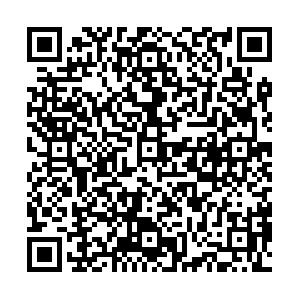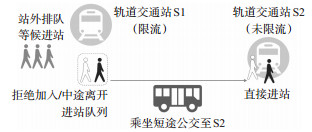Travel Mode Choice of Passengers Under Passenger Flow Control of Rail Transit During Public Health Events
-
摘要: 为减少重大公共卫生事件场景下城市轨道交通限流运行带来的负面影响,采用短途公交将限流车站站外候车乘客运送至周边未限流车站。分析了短途公交引入后乘客出行方式选择行为,探究利用短途公交疏解轨道交通限流车站客流的可行性。通过线上调查北京、上海、广州、深圳城市居民共回收989份有效问卷;基于问卷调查数据构建重大公共卫生事件下轨道交通限流时乘客出行方式选择Logit模型,研究此情境下影响乘客选择轨道交通单一出行方式和短途公交与轨道交通组合出行方式的显著因素及其影响作用;探索在不同的疫情感知程度下,乘客偏好对组合出行方式选择概率的调节作用;对比分析不同城市、不同类别乘客出行方式选择行为影响因素。结果表明:出行准时性偏好、出行舒适性偏好与疫情感知程度对乘客选择组合出行方式产生正向显著影响;其中,出行准时性偏好对北京、上海、广州、深圳居民选择组合出行方式均产生积极影响,对长距离直达乘客选择组合出行方式的正向影响最为显著。多因素交叉影响分析中发现,疫情感知程度为2级及以上时,对出行准时性、出行舒适性存在显著偏好的乘客选择组合出行方式的概率超过57%和53%。这些结论表明重大公共卫生事件下准时舒适的短途公交服务可以有效均衡轨道交通站点间客流负载。Abstract: To lessen the negative effects of passenger flow control during major public health events, it is suggested to employ the short-distance buses to transport waiting passengers from the restricted-flow station to the nearby stations that are operating normally. Travel mode choice of passengers toward the short-distance buses is modeled to analyze the feasibility of utilizing short-distance buses to reduce congestions at flow-restricted metro stations. A total of 989 valid questionnaires are obtained using an online survey conducted among residents in Beijing, Shanghai, Guangzhou, and Shenzhen, based on which a Logit model is established to analyze passengers' mode choices during the period of passenger flow control under major public health events. The model explores the determinants of passengers' choice between rail transit as a singular mode and the combined mode of short-distance buses and metro. Furthermore, the effects of passengers' preferences on the probability of choosing the combined travel mode under different levels of epidemic perceptions are also studied. The factors influencing the choices of travel modes of passengers among different cities and groups are compared. The results indicate that punctuality preference, comfort preference, and level of epidemic perception have a positive and significant effect on passengers' choice of the combined travel mode. Specifically, the preference toward punctuality has a significantly positive effect on the travel mode choices of the residents in all the four cities, and it has the largest effect on passengers of long-distance and direct travels. Furthermore, the results of cross-impact analysis indicate that when the epidemic perception is at Level 2 or above, the probability of passengers with a significant preference toward punctuality and comfort choosing the combined travel mode is more than 57% and 53%, respectively. The findings imply that punctual and comfortable short-distance buses can effectively equilibrate passenger distribution among metro stations during major public health events.
-
Key words:
- urban transport /
- public transport /
- travel mode choice /
- Logit model /
- passenger flow control
-
表 1 验证性因子分析结果
Table 1. Confirmatory factor analysis results
指标 判断标准值[15] 模型值 近似误差均方根 ≤0.080 0.062 拟合优度指数 ≥0.900 0.955 非规范拟合系数 > 0.9 0.911 表 2 个人属性、出行特征与公交服务接受程度
Table 2. Personal attributes, travel characteristics, and passenger acceptance of bus services
属性类别 特征变量 变量定义(样本百分比/%) 个人属性 A1 男(40.44)、女(59.56) A2 ≤20岁(3.44)、>20~30岁(47.12)、>30~40岁(38.42)、>40~50岁(8.7)、>50岁(2.32) A3 高中及以下(5.46)、大专(12.34)、本科(71.99)、硕士及以上(10.21) 出行特征 B1 ≤30 min(31.55)、>30~60 min(54.7)、>60~90 min(12.54)、>90 min(1.21) B2 0天(12.74)、1天(7.89)、2天(14.16)、3天(9.61)、4天(6.76)、≥5天(48.84) B3 0次(25.38)、1次(37.92)、2次(26.49)、3次(6.77)、≥4次(3.44) B4 ≤3.0元(24.87)、>3.0~6.0元(51.16)、>6.0~9.0元(19.82)、>9.0元(4.15) 公交服务接受程度 C1 10 min(32.05)、15 min(36.20)、20 min(21.33)、≥25 min(10.41) C2 5 min(30.94)、10 min(38.42)、15 min(23.46)、≥20 min(7.18) C3 无需“一人一座”(77.15)、需“一人一座”(22.85) C4 免费(16.38)、50%常规公交票价(23.86)、75%常规公交票价(15.98)、常规公交票价(43.78) 表 3 Logit模型参数
Table 3. Parameters of the Logit model
量 系数 标准差 统计量 自由度 显著性水平 优势比 D3 -0.668 0.095 49.802 1 < 0.001 0.513 D2 0.633 0.109 33.732 1 < 0.001 1.883 D5 0.330 0.094 12.307 1 < 0.001 1.391 D1 -0.329 0.113 8.384 1 0.004 0.720 C2 -0.280 0.080 12.206 1 < 0.001 0.756 D4 0.187 0.096 3.382 1 0.050 1.206 常量 0.520 0.617 0.709 1 0.400 1.682 表 4 不同城市类别下Logit模型参数
Table 4. Parameters of Logit models built for different cities
城市 变量 系数 优势比 北京 C3 0.926 2.525 D2 0.721 2.057 D1 -0.418 0.658 常量 -0.289 0.749 上海 D3 -0.825 0.438 D2 0.587 1.799 D4 0.467 1.595 C2 -0.364 0.695 常量 0.372 1.450 广州 D2 0.739 2.094 D3 -0.712 0.491 C2 -0.329 0.720 常量 1.190 3.286 深圳 D3 -0.911 0.402 D2 0.732 2.078 常量 1.329 3.776 -
[1] 马飞, 赵成勇, 孙启鹏, 等. 重大公共卫生灾害主动限流背景下城市轨道交通网络集成韧性[J]. 交通运输工程学报, 2023, 23 (1): 208-221.MA F, ZHAO C Y, SUN Q P, et al. Integrated resilience of urban rail transit network with active passenger flow restriction under major public health disasters[J]. Journal of Traffic and Transportation Engineering, 2023, 23 (1): 208-221. (in Chinese) [2] LU Y, YANG L, YANG H, et al. Robust collaborative passenger flow control on a congested metro line: a joint optimization with train timetabling[J]. Transportation Research Part B: Methodological, 2023, 168: 27-55. doi: 10.1016/j.trb.2022.12.008 [3] 孟凡婷, 杨立兴, 卢亚菡, 等. 考虑跳停策略的城轨列车运行图与车站限流协同优化研究[J]. 交通运输系统工程与信息, 2021, 21 (3): 156-162.MENG F T, YANG L X, LU Y H, et al. Collaborative optimization of urban rail transit operation and passenger flow control at stations using skip-stop pattern strategy[J]. Journal of Transportation Systems Engineering and Information Technology, 2021, 21 (3): 156-162. (in Chinese) [4] ZHOU H, QI J, YANG L, et al. Joint optimization of train scheduling and rolling stock circulation planning with passenger flow control on tidal overcrowded metro lines[J]. Transportation Research Part C: Emerging Technologies, 2022, 140: 103708. doi: 10.1016/j.trc.2022.103708 [5] YUAN Y, LI S, YANG L, et al. Real-time optimization of train regulation and passenger flow control for urban rail transit network under frequent disturbances[J]. Transportation Research Part E: Logistics and Transportation Review, 2022, 168: 102942. doi: 10.1016/j.tre.2022.102942 [6] 贾斌, 朱凌, 李树凯, 等. 城市轨道交通小交路计划与客流控制协同优化策略[J]. 交通运输系统工程与信息, 2022, 22 (1): 124-132.JIA B, ZHU L, LI S K, et al. Collaborative optimization strategy of short-turning plan and passenger flow control in urban rail transit[J]. Journal of Transportation Systems Engineering and Information Technology, 2022, 22 (1): 124-132. (in Chinese) [7] 赵源, 陈菁菁, 廖沈美慧, 等. 新型冠状病毒肺炎疫情对上海轨道交通客流的影响及防控措施分析[J]. 城市轨道交通研究, 2020, 23 (10): 1-4, 9.ZHAO Y, CHEN J J, LIAO S M H, et al. Impact of COVID-19 on passenger flow in shanghai metro and prevention measures analysis[J]. Urban Mass Transit, 2020, 23(10): 1-4, 9. (in Chinese) [8] 刘斌, 丁波, 彭瑾蓉, 等. 新型冠状病毒肺炎疫情防控期间武汉地铁客流控制方案研究及评估[J]. 铁道科学与工程学报, 2020, 17 (9): 2397-2403.LIU B, DIND B, PEND J R, et al. Research and assessment of Wuhan metro passenger flow control scheme during the corona virus disease 2019 prevention and control period[J]. Journal of Railway Science and Engineering, 2020, 17(9): 2397-2403. (in Chinese) [9] 胡松, 翁剑成, 周伟, 等. 基于关联分析的乘客公共交通依赖度识别方法[J]. 交通运输系统工程与信息, 2020, 20 (4): 136-142.HU S, WENG J C, ZHOU W, et al. Identification method of passenger's dependence level of public transportation based on correlation analysis[J]. Journal of Transportation Systems Engineering and Information Technology, 2020, 20(4): 136-142. (in Chinese) [10] 胡松, 杨贝, 翁剑成, 等. 基于关联规则的居民公共交通依赖性致因分析[J]. 交通信息与安全, 2023, 41(3): 147-156. doi: 10.3963/j.jssn.1674-4861.2023.03.016HU S, YANG B, WENG J C, et al. A cause analysis of residents'dependence on public transportation based on association rules[J]. Journal of Transport Information and Safety, 2023, 41 (3): 147-156. (in Chinese) doi: 10.3963/j.jssn.1674-4861.2023.03.016 [11] 杨亚璪, 唐浩冬, 彭勇. 考虑偏好差异的后疫情时代居民出行方式选择行为研究[J]. 交通运输系统工程与信息, 2022, 22 (3): 15-24.YANG Y Z, TANG H D, PENG Y. Residents' travel mode choice behavior in post-COVID-19 era considering preference differences[J]. Journal of Transportation Systems Engineering and Information Technology, 2022, 22(3): 15-24. (in Chinese) [12] ZHAO P, GAO Y. Public transit travel choice in the post COVID-19 pandemic era: an application of the extended Theory of Planned behavior[J]. Travel Behaviour and Society, 2022, 28: 181-195. doi: 10.1016/j.tbs.2022.04.002 [13] WANG Y, GAO Y. Travel satisfaction and travel well-being: which is more related to travel choice behaviour in the post COVID-19 pandemic? Evidence from public transport travellers in Xi' an, China[J]. Transportation Research Part A: Policy and Practice, 2022, 166: 218-233. doi: 10.1016/j.tra.2022.10.003 [14] 魏丽英, 刘鲁建. 新冠肺炎疫情下居民出行方式选择行为分析[J]. 北京交通大学学报, 2022, 46 (6): 52-61, 92.WEI L Y, LIU L J. Analysis of residents' travel mode choice during COVID-19 pandemic[J]. Journal of Beijing Jiaotong University, 2022, 46 (6): 52-61, 92. (in Chinese) [15] 胡鹏, 路红, 马子程. 验证性因子分析中允许误差相关的可行性与条件性[J]. 统计与决策, 2018, 34 (19): 37-41.HU P, LU H, MA Z C. Feasibility and condition of allowable error correlation in confirmatory factor analysis[J]. Statistics & Decision, 2018, 34 (19): 37-41. (in Chinese) [16] 周悦, 江欣国, 付川云, 等. 基于混合Logit模型的出租车超速者运营因素分析[J]. 交通运输系统工程与信息, 2021, 21 (3): 229-236.ZHOU Y, WANG X G, FU C Y, et. al. Operational factors analysis for taxi speeders using mixed Logit model[J]. Journal of Transportation Systems Engineering and Information Technology, 2021, 21 (3): 229-236. (in Chinese) [17] 杨少伟, 梁汉冕, 潘兵宏. 基于二元Logit模型的驾驶员收费车道选择研究[J]. 重庆交通大学学报(自然科学版), 2021, 40 (1): 29-35.YANG S W, LIANG H M, PAN B H. Driver's toll lane selection based on binary Logit model[J]. Journal of Chongqing Jiaotong University(Natural Science), 2021, 40(1): 29-35. (in Chinese) [18] AADITYA B, RAHUL T M. Long-term impacts of COVID-19 pandemic on travel behaviour[J]. Travel Behaviour and Society, 2023, 30: 262-270. doi: 10.1016/j.tbs.2022.10.005 [19] 刘宇峰, 安韬, 钱一之, 等. 不同规模城市居民出行方式影响因素分析[J]. 中国公路学报, 2022, 35 (4): 286-297.LIUY F, AN T, QIAN Y Z, et al. Exploring influence factors for travel mode choice in cities with different scales[J]. China Journal of Highway and Transport, 2022, 35(4): 286-297. (in Chinese) [20] 庄焱, 董春娇, 米雪玉, 等. 基于随机参数Logit的中小城市居民出行方式选择建模[J]. 吉林大学学报(工学版), 2024, 54 (2): 461-468.ZHUANG Y, DONG C J, MI X Y, et al. Travel mode choice in small and media sized city based on random parameters Logit model[J]. Journal of Jilin University(Engineering and Technology Edition), 2024, 54 (2): 461-468. (in Chinese) -





 下载:
下载:






